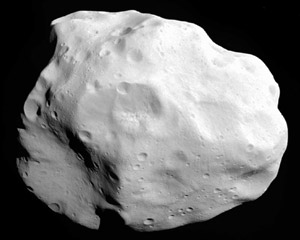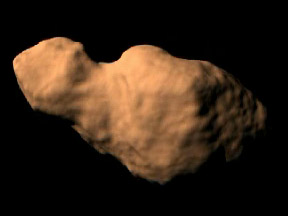Asteroids
| Name | Year of discovery |
Discoverer | Diameter |
Average Distance from Sun | Orbital period |
|
|---|---|---|---|---|---|---|
| Amphitrite | 1854 | A. Marth | 240 | 2.554 | 382.1 | 4.08 |
| Camilla | 1868 | N. Pogson | 236 | 3.488 | 521.8 | 6.50 |
| Chiron | 1977 | C. Kowal | 180 | 13.716 | 2051.9 | 50.80 |
| Cybele | 1861 | E. Tempel | 246 | 3.429 | 513.0 | 6.37 |
| Daphne | 1856 | H. Goldschmidt | 182 | 2.765 | 413.6 | 4.59 |
| Davida | 1903 | R. Dugan | 336 | 3.178 | 475.4 | 5.67 |
| Doris | 1857 | H. Goldschmidt | 226 | 3.112 | 465.5 | 5.48 |
| Egeria | 1850 | A. de Gasparis | 114 | 2.576 | 385.4 | 4.14 |
| Elpis | 1860 | J. Chacornac | 174 | 2.713 | 405.9 | 4.47 |
| Eros | 1898 | G. Witt | 33 | 1.46 | 218.4 | 33 |
| Eugenia | 1857 | H. Goldschmidt | 114 | 2.721 | 407.1 | 4.49 |
| Eunomia | 1851 | A. De Gasparis | 272 | 2.644 | 395.5 | 4.30 |
| Euphrosyne | 1854 | J. Ferguson | 248 | 3.156 | 472.1 | 5.58 |
| Europa | 1858 | H. Goldschmidt | 312 | 3.097 | 463.3 | 5.46 |
| Freia | 1862 | H. d'Arrest | 190 | 3.390 | 466.6 | 5.49 |
| Hebe | 1847 | K. Hencke | 192 | 2.425 | 362.8 | 3.78 |
| Hygiea | 1849 | A. De Gasparis | 430 | 3.144 | 470.3 | 5.59 |
| Interamnia | 1910 | V. Cerulli | 334 | 3.062 | 458.1 | 5.36 |
| Iris | 1847 | J. Hind | 204 | 2.386 | 356.9 | 3.68 |
| Juno | 1804 | K. Harding | 244 | 2.670 | 399.4 | 4.36 |
| Kalliope | 1852 | J. Hind | 188 | 2.910 | 435.3 | 4.97 |
| Lutetia | 1852 | H. Goldschmidt | 96 | 2.435 | 364.3 | 3.80 |
| Mathilde | 1885 | Johann Palisa | 61 | 2.46 | 290 | 4.3 |
| Pallas | 1802 | H. Olbers | 522 | 2.771 | 414.5 | 4.61 |
| Psyche | 1852 | A. De Gasparis | 264 | 2.922 | 437.1 | 5.00 |
| Sylvia | 1866 | N. Pogson | 272 | 3.486 | 521.5 | 6.52 |
| Toutatis | 1989 | C. Pollas | 4.6 x 2.29 x 1.92 | 2.512 | 375.8 | 3.98 |
| Vesta | 1807 | H. Olbers | 500 | 2.362 | 353.4 | 3.63 |
Last modified July 15, 2010 by Randy Russell.
What's New on the Site?
When Nature Strikes - Earthquakes
When Nature Strikes - Volcanoes
When Nature Strikes: Tsunami Classroom Activity
When Nature Strikes: Wildfires - Why are they a challenge to stop?
Windows to the Universe Community | |
News | Opportunities |
You might also be interested in:

Cool It! Game
Check out our online store - minerals, fossils, books, activities, jewelry, and household items!...more
Asteroid Lutetia
Lutetia is a medium-sized asteroid which orbits in the main asteroid belt between the planets Mars and Jupiter. It is officially known as "21 Lutetia" because it was the 21st asteroid discovered. The asteroid...more
NEAR FLyby of Asteroid Mathilde
On June 27, 1997, the NEAR spacecraft passed within 1200 km of the asteroid Mathilde. NEAR stands for Near Earth Asteroid Rendevous. It is one of NASA's Discovery missions, a series of small-scale spacecraft...more
Asteroid Toutatis
Toutatis is a very odd asteroid. It appears to be two asteroids that are either loosely stuck together, rolling around against each other, or orbiting very close to one another. The orbit of Toutatis crosses...more
NEAR to Touchdown on Surface of Asteroid!
The NEAR spacecraft has been in orbit around the asteroid Eros since Valentine's Day of last year. It has met all of its science goals. It has been a huge success within NASA's low-cost planetary exploration...more
Pluto demoted - no longer a Planet!
Pluto has been officially demoted from its status as a planet. The International Astronomical Union (IAU), at a meeting in August 2006, voted on their first "official" definition of a planet....morePlease log in
Science Blogs
Real Climate: climate science from climate scientists

Windows to the Universe, a project of the National Earth Science Teachers Association, is sponsored in part is sponsored in part through grants from federal agencies (NASA and NOAA), and partnerships with affiliated organizations, including the American Geophysical Union, the Howard Hughes Medical Institute, the Earth System Information Partnership, the American Meteorological Society, the National Center for Science Education, and TERC. The American Geophysical Union and the American Geosciences Institute are Windows to the Universe Founding Partners. NESTA welcomes new Institutional Affiliates in support of our ongoing programs, as well as collaborations on new projects. Contact NESTA for more information.





